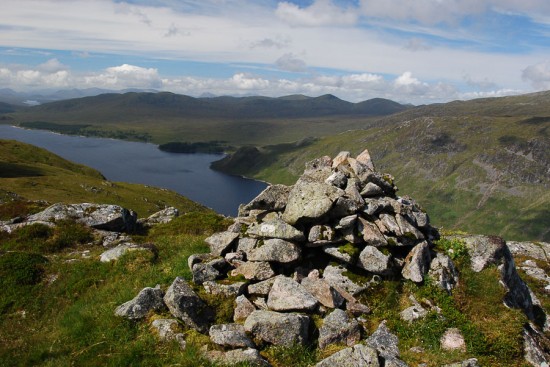The John Muir Trust has urged Highland Perthshire residents and visitors to object to a major wind farm on the Talladh-a-Bheithe estate between Loch Rannoch and Loch Ericht.
As well as being located in the heart the Wild Land Area Rannoch-Nevis-Mamores-Alder, the 24-turbines each 125 metres high, would be visible from over 30 Munros and Corbetts, the iconic West Highland Railway line and the A82 – the main tourist route through the West Highlands.
The Trust is set to submit its own detailed objection to both Perth and Kinross Council and the Scottish Government’s Energy Consents and Deployment Unit (ECDU).
John Low, Policy Officer at the John Muir Trust, said: “Just last month the Scottish Government agreed a Wild Land Areas map, along with new planning documents proposing stronger protection for these areas from large-scale energy developments.

View from Ston an Aonaich Mhoir – the approach would be through the windfarm
“If this application were to succeed, it would fatally undermine the map and make a mockery of the democratic procedures of the Scottish Parliament.
“We would ask local residents and visitors familiar with the area to submit their own objections to the Scottish Government’s Energy Consents Unitand copy it to Perth and Kinross Council before the closing date of Tuesday 5 August.”
The application has been submitted by Netherlands-based developer, Eventus BV, of which the Talladh-a-Bheithe landowner is a major shareholder.
Local tourism businesses are also fighting the plans. Rose La Terriere, who runs self-catering cottages in the area, said: “We have been letting holiday cottages to visitors for over 40 years. Visitors come from Scotland and overseas for the tranquillity and unspoilt landscape of this glen of Rannoch. They walk the hills and climb, bird- and animal-watch and enjoy the moors, hills and forests of this beautiful area. We are like an island or oasis, but surrounded by hills rather than water.
“Many people believe Schiehallion has healing powers; whether or not you believe this, there is something very special about this hill. The proposed wind farm will be seen from the slopes of Schiehallion and from very many others of our hills and from the south side road of Loch Rannoch and many popular paths.”
“I sincerely believe that the very unique offering of our tourism business and others in the glen will be destroyed by this development. Given that farming is fading in glens like ours any loss of tourists would destroy the community.”
Louise Hardwick, who also runs a local businesses providing holiday cottages, is also fearful about what the wind farm would mean, and said: “We provide six self-catering holiday cottages and are worried about the effect this development would have on our business and others in the area.
“Our guests come to relax in remote and beautiful surroundings with spectacular panoramic views of the loch and surrounding mountains, to take advantage of the many excellent walking, climbing, cycling, fishing and wild life watching opportunities the glen affords.
“I can see no reason for visitors to travel to such a remote area simply to see a wind farm from every view point around the loch including Ben Alder, Schiehallion and other Munros. This is a special area of scenic beauty which attracts visitors from around the globe; they in turn maintain the tourism employment and economy of the area.”
The Talladh a Bheithe wind farm is being proposed at the very moment when the Scottish Government claims it is getting serious about protecting wild lands from industrialisation. It will be a test case for new planning guidance it says will achieve this.
David Gibson, Chief Officer of the Mountaineering Council of Scotland which is also fighting the plans, said: “If Scottish Government Ministers are serious about protecting Scotland’s rapidly dwindling wild lands then they will recognise that this scheme must be refused consent.
“The MCofS supports local residents and businesses in wanting a sustainable future for their communities – one where the wild lands are cherished and where they provide the foundation for a sustainable tourism economy.
“The wild lands of areas like Rannoch are exactly what make Scotland so special for visitors, whether they want to walk, climb, cycle or simply relax. To squander this superb national asset would damage our country’s reputation as a destination and the fragile local economy by driving visitors elsewhere.”
